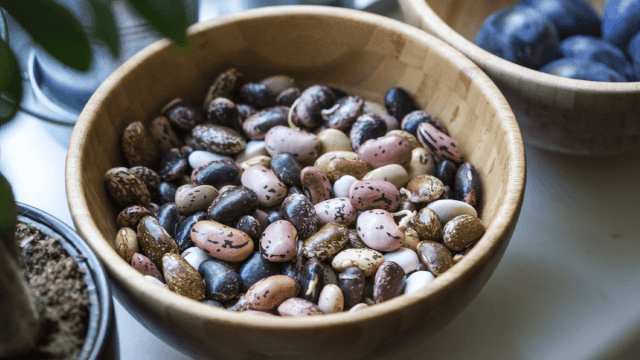Whether you’re baking it, brewing it or eating it bare, the humble bean is an important staple of plenty of worldwide cuisines. Beans around the world come in many shapes, sizes and colors. And just like tomatoes, potatoes and chocolate, they have captured the hearts and filled the stomachs of the world’s people in all types of ways — and through a whole host of dishes and culinary creations.
Legumes, the category of food that includes beans, lentils, peas and chickpeas, are an essential element of healthy diets in parts of the planet near and far and have been for millennia, since the earliest days humans foraged for food and harnessed the power of agriculture. They’re versatile and can be eaten either alone or as a part of a more complete dish. And they’re packed with protein and fiber and scores of other nutrients to nourish and nurture you.
Read on to find out more about the role of beans around the world and how they’ve shaped the unfolding of cultures across the planet.
Beloved Beans Around The World
Mexico
One of Mexico’s most popular bean dishes is frijoles de la olla, which is a traditional bean stew with a name that translates roughly to “beans in the pot.” It’s one of the most recognizable meals in a country where beans, along with corn and chiles, form a major part of the everyday diet. The dish is known for its simplicity — you can prepare it by soaking then cooking beans in water over a few hours and adding seasonings, cream or cheese — which makes it extraordinarily popular as a main meal or as a side dish, for slurping with a spoon or dipping a tortilla into.
The beans most often used in this classic dish are called flor de junio, a creamy bean from the central part of the country, but many Mexicans also use pinto or black beans.
New Orleans, Louisiana
In New Orleans, Louisiana, the French- and Caribbean-inspired creole cuisine wouldn’t be complete without red beans and rice, a time-honored culinary tradition that captures the eclectic tastes and history of the city’s residents. A pot of red or kidney beans is stewed and simmered slowly with any type of meat — from ham hocks to pork to andouille sausage — and garnished with all sorts of mouthwatering spices and topped with rice and often some vegetables.
Bean dishes are a Monday tradition, as households would historically take care of their weekly laundry and other chores while waiting for the beans to cook in the bones leftover from Sunday dinner, to be enjoyed with family at the end of a long day of domestic duties. Paired with cornbread, collards or corn on the cob, it’s the perfect hearty meal to fill you up — and extremely easy to prepare!
France
Jump over to southwest France, and you’ll find the cassoulet, a casserole named for the pot it’s cooked in — the cassole. This heavy, rich and hearty bean-focused dish is often considered to be one of French home cooking’s most laborious (and most delicious) undertakings if you’re willing to put in the effort. Most forms of this classic French creation are based around white haricot beans, or sometimes fava beans, and some type of pork, but many cooks and chefs switch it up by adding duck or duck confit, sausages and mutton, among other meats.
Historically, cassoulet was a food made by and for the peasantry, an amalgamation of whatever was convenient, close by and cookable. Today, it’s recreated by all types of French cuisine enthusiasts both inside and outside the country’s borders.
Egypt
Have you ever thought of having beans for breakfast? South of the Mediterranean in Egypt, the national dish is ful medames, a breakfast fava bean stew made with vegetable oil, herbs and spices and thought to be as old as the pharaohs (and loved so much that it’s really eaten at any time of day).
England
Though you might find the sight of baked beans in the morning repulsive, the Brits include them as them an important part of a full English breakfast, accompanied by tomatoes, bacon, fried eggs, sausages, mushrooms, fried bread and black pudding.
India
Indians love beans because their diets are largely vegetarian, and these food staples are rich with protein. You can find beans and other legumes featured throughout Indian cuisine in dishes like curries, salads, soups and the famous Indian dal. Some of the most popular beans (not counting the wide variety of lentils that are a staple of the Indian diet) are black eyed peas, kidney beans, mung beans and garbanzo beans, also known as chickpeas.
China
Beans around the world can appeal to the sweet-toothed, too, especially in mainland Asia. In China, it’s common to find sugary red beans used in all types of desserts — in the form of a paste that can be found in buns or as a part of sticky rice cakes, for example. Red adzuki beans are combined with tapioca pearls and Chinese rock sugar to make red bean soup, often garnished with dried orange peels and coconut milk and eaten as a sweet cap to the end of a delicious savory meal.
By adding cornstarch and flour, you can even make a delectable red bean pudding that’s a perfect, festive way to ring in the Lunar New Year.
And The Rest!
Of course, there are plenty more types of beans around the world we didn’t cover here — and even more ways that the people of the world have incorporated them into wholesome and hunger-inducing recipes. There are so many beans to explore, so get cooking and bean appetit!
